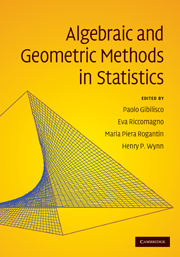Book contents
- Frontmatter
- Contents
- List of contributors
- Preface
- Frequently used notations and symbols
- 1 Algebraic and geometric methods in statistics
- Part I Contingency tables
- Part II Designed experiments
- Part III Information geometry
- 14 Introduction to non-parametric estimation
- 15 The Banach manifold of quantum states
- 16 On quantum information manifolds
- 17 Axiomatic geometries for text documents
- 18 Exponential manifold by reproducing kernel Hilbert spaces
- 19 Geometry of extended exponential models
- 20 Quantum statistics and measures of quantum information
- Part IV Information geometry and algebraic statistics
- Part V On-line supplements
20 - Quantum statistics and measures of quantum information
from Part III - Information geometry
Published online by Cambridge University Press: 27 May 2010
- Frontmatter
- Contents
- List of contributors
- Preface
- Frequently used notations and symbols
- 1 Algebraic and geometric methods in statistics
- Part I Contingency tables
- Part II Designed experiments
- Part III Information geometry
- 14 Introduction to non-parametric estimation
- 15 The Banach manifold of quantum states
- 16 On quantum information manifolds
- 17 Axiomatic geometries for text documents
- 18 Exponential manifold by reproducing kernel Hilbert spaces
- 19 Geometry of extended exponential models
- 20 Quantum statistics and measures of quantum information
- Part IV Information geometry and algebraic statistics
- Part V On-line supplements
Summary
The geometrical formulation of quantum statistics and the theory of measures of quantum information are intimately connected by the introduction of the notion of metric adjusted skew information.We survey the area with a focus on the ‘representing operator monotone functions’. In particular, we exhibit a new order structure that renders the set of metric adjusted skew informations into a lattice with a maximal element. The Wigner–Yanase–Dyson skew informations (with parameter p) are increasing with respect to this order structure for 0 < p ≤ 1/2 and decreasing for 1/2 ≤ p < 1 with maximum in the Wigner–Yanase skew information.
Introduction
The geometrical formulation of quantum statistics and the theory of measures of quantum information are two distinct theories with separate motivations and histories, and for a long time they did not seem to be related in any way. Early contributions which view quantum information in statistical terms were given by Hasegawa and Petz (Hasegawa and Petz 1996), and by Luo (Luo 2003a, Luo 2003b, Luo 2005). Today the two theories are largely fused with the notion of metric (or metrically) adjusted skew information and a common set of tools and techniques involving certain operator monotone functions and their representations.
The geometrical approach to statistics reveals its fundamental nature when we try to generalise classical statistics to the quantum setting. The key to obtaining quantisation of the Fisher information is to consider it as a Riemannian metric with a certain behaviour in the presence of noise.
- Type
- Chapter
- Information
- Algebraic and Geometric Methods in Statistics , pp. 327 - 338Publisher: Cambridge University PressPrint publication year: 2009



